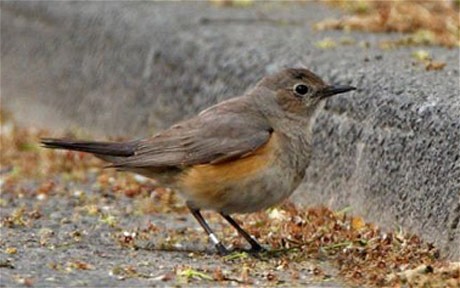Flaparazzi – is that a new word?
The siege of Hartlepool.
A new word has been coined for the UK Twitchers. And it is not very nice. Flaparazzi. In two The Telegraph articles about the British Birdwatching scene, the word is used to describe the mad recent twitch to Hartlepool, where a White-throated Robin Irania gutturalis had turned up in the garden of Dr Michaal Reece behind his 3m walls. That would not stop the Flaparazzi. 5000 birders showed up in Hartlepool to get a glimpse of the bird. The excerpt from the Telegraph article gives you a good idea what was going on – and what Tom McKinney was doing last Monday.
The “flaparazzi” were at it again last week, bringing pandemonium to a quiet suburban street in Hartlepool, where a white-throated robin of a type only twice before seen in Britain landed in the garden of Dr Michael Reece. On Tuesday lunchtime, the GP came home from his surgery to find the neighbourhood looking like a medieval siege camp, with thousands lining the pavements and overwrought “twitchers” shinning up the property’s 10ft walls for a view.
The robin – usually found in the rugged mountain regions of Turkey and Armenia – had first alighted on a nearby bowling green, where local ornithologist Chris Brown misidentified it as a red-flanked bluetail from Russia.
Interesting, but not enough to trigger the stampede that would soon follow. It was some hours later, after the bird relocated to Dr Reece’s flowerbeds and its true identity was established, that the frenzy began. “This was as big as it gets in birdwatching,” says Lee Evans, Britain’s Buckinghamshire-based “King of the Twitchers”. “When it broke, blokes all over the country would have stopped what they were doing, grabbed their cameras, jumped in their cars and headed for Hartlepool. I mean, they would have run out of their offices, abandoned their trolleys in supermarkets, left things cooking in the oven. When you get something like this, the only thing that matters is being there.”
Read the full article at the Telegraph. It is very good read.
Here is a video from the siege of Hartlepool. It looks like an attack of a medieval fortress.
Also check this brilliant Black and White Flickr album called Bird Alert by Brett T.
Another Telegraph article describes how 6 million (I am sure that number is exaggerated) UK birdwatchers almost step on each other and that there are virtual fights between photographers and traditional birders with telescopes and binoculars.
Fights have broken out over limited spaces in hides, while there are an increasing number of reports of birdwatchers trespassing and causing criminal damage to private property, in their determination to spot species.
In some cases, rare birds have been “harassed” and distressed by birdwatchers getting too close and some are even reported to have died as a result. And watchers are instructed not to hack away at vegetation to get a better look at a bird and are reminded that they must always get permission from landowners to go on their property. The use of live mice to lure predatory birds such as raptors and owls is also discouraged.
One of the most common flash points comes between photographers and birdwatchers using traditional telescopes and binoculars. These are more powerful so there is less need to get as close to the bird as those with cameras. However, photographers are often blamed for getting too near to birds and sometimes deliberately “flushing” them, in order to get “action shots”.
Read the rest of this article in The Telegraph.


Hi Gunnar,
I have to disagree about that Daily Telegraph article – it’s a poor piece of journalism, not based soundly in fact or checked for accuracy. There are not 6 million UK birdwatchers (as you correctly guessed), no one knows how many people went to Hartlepool to see the White-throated Robin (but probably nothing like approaching 5,000), punch-ups at twitches are rarer than hens’ teeth, there is no British Birding Association (just because one person keeps saying it doesn’t make it true) and so on … I could go on, but you get the message. This is over-hyped, sensationalised reporting which doesn’t reflect the truth, and doesn’t do birding or birders any favours. It does sell newspapers and get free publicity everywhere, however, so the Daily Telegraph got what it wanted.
Rgds
Dominic Mitchell/www.birdingetc.com
Hi Dominic
Yes, the article is a bit sloppy I agree, but neither the black and white photo or the video are from The Telegraph. Even if the articles are exaggerated you have to admit that this looks very far from what most people associate what birding is all about. I am not condemning. I’d probably be one of the crowd if I were in the UK – but one has to look at it from the other side as well. It does look like madness!
The question soon becomes – what should be done? Say there would have been 5000 people going on a twitch to someone’s garden. What is the saturating number of twitchers in the UK? How many UK twitchers are – TOO MANY?
Also, what kind of articles should the press write, that is favorable to birding and birders? When the twitches look like the pictures from that gallery and the video, what else can we expect? Maybe, an activity that would put the twitchers in good light could inspire some change. A united front to do a Spring Watch on Malta for example. Say the 100 top twitchers were to set off a week next spring on Malta to help BirdLife Malta monitor illegal hunting. That would set a good example for the lower ranks twitchers to copy and it would be something very positive that the The Telegraph and their likes could write about.
Saludos
Gunnar